Feb 23, 2007Schiff Nutrition International is tagging 180 cases per week on several of its nutritional supplements bound for three RFID-enabled Wal-Mart distribution centers.
The vitamin and supplement manufacturer is affixing EPC Gen 2 passive UHF RFID tags on cases of Schiff Move-Free, Schiff Glucosamine and four of the company's other joint-care nutritional supplements. Once tagged, the cases are stacked onto pallets, which are also tagged and stretch-wrapped, then sent to Wal-Mart. Each pallet contains a mix of the six different stock-keeping units (SKUs).
Schiff, based in Salt Lake City, started its RFID project in May 2006 when it learned it would be one of 200 suppliers mandated by Wal-Mart to apply RFID tags to shipments by January 2007. The midsize company, which reported revenues of $178.4 million in fiscal year 2006, didn't hesitate to begin testing RFID, says Rod Farrimond, Schiff's manager of business analysis. "One of the things we've recognized as a company is that the whole industry is looking for a return on investment with RFID," he says. "Still, we know that it is important to serve our customers [retailers] and the consumers with quality products, and Schiff can adapt to reasonable initiatives designed to help improve the entire supply chain and thus improve quality."
Schiff partnered with IBM to design, test and implement its RFID initiative, which included testing at IBM's RFID lab in Raleigh, N.C. Schiff is using Printronix tags and printers-encoders, as well as interrogators from Alien Technology. For the project's middleware, Schiff turned to OATSystems' OATxpress and IBM's WebSphere RFID Premises Server.
After a two-week trial run in late October and early November at its distribution center, Farrimond says, Schiff sent its first RFID-tagged shipment to Wal-Mart on Nov. 17. Since January, the firm has been shipping all orders of the six SKUs to the three Wal-Mart DCs. According to Farrimond, Schiff has been able to read the mixed pallets 100 percent of the time, while Wal-Mart has been getting read rates of 97 percent at its facilities.
Crucial to Schiff's implementation was the ability to integrate RFID into its pack-and-ship processes with minimal interruptions. Farrimond notes that Schiff preferred not to require employees stacking cases onto products to follow any specific rules, such as stacking them so all RFID tags face outward. "I can't have them out there trying to engineer an RF-friendly pallet," he says.
Additionally, the company wanted to be able to read the tags on the cases as the pallet was being wrapped with clear plastic, then aggregate all the tags' unique ID numbers so they could be associated with the unique ID number encoded on the pallet's RFID tag.
Numerous tests were conducted, including multiple scenarios to find the right tag, reader and reader-tag combination. IBM and Schiff then built a structure similar to a half-portal with one reader and four antennas, able to read the pallet and case tags while the pallet is being stretch-wrapped. Once the tags have been read, the pallet is shipped on to Wal-Mart.
For now, Schiff will keep its RFID implementation as is, but Farrimond says the company expects to expand its use of RFID in the future. Schiff hopes to tightly integrate the RFID middleware with its back-end enterprise resource planning (ERP) software so it can automatically create advance shipping notices (ASNs) to be sent to customers when the pallets ship. With ASNs and back-end integration, Schiff would be able to quickly and accurately investigate and respond to credit requests from customers complaining that their cases or pallets were incompletely packed. "This helps us work with Wal-Mart and other customers to know that the customers got what we sent them."
Deeper integration of RFID data with Schiff's back-end systems will also enable the company to create product pedigrees. A pedigree, either paper- or electronic-based, documents the movement of products up and down a supply chain, verifying that the product is authentic and deterring the introduction of counterfeit goods into the supply chain.
In addition, Schiff is keeping an eye on initiatives in the pharmaceutical sector, including item-level tagging, though Farrimond acknowledges item-level tagging is much further away in the company's future. Schiff is regulated by rules developed by the U.S. Office of Nutritional Products, Labeling, and Dietary Supplements (ONPLDS), a division of the U.S. Food and Drug Administration (FDA).
Currently, the FDA is advocating the use of RFID to create pedigrees for prescription drugs in an effort to combat drug counterfeiting and improve drug safety. However, it has not issued similar recommendations for nutritional supplements.
Schiff, like other companies, will continue to monitor RFID's progression in the supply chain, and will pay close attention to RFID's return on investment. "RFID is one of these initiatives where ROI will be seen in top-line growth," says Farrimond, explaining that although RFID can't be tied directly to increased sales, it can contribute to a more efficient supply chain—and that can be tied to increased sales.


